443 Mastini
THE MASTIFFS FROM ITALY
by David Hancock
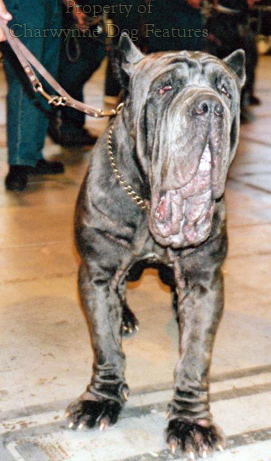 It is likely that the mastiffs, as a group of dogs, can lay claim to being the group most misused by man. Developed to pull down big game, such as wild bull, auroch, stag, boar and bison, many more hunting mastiffs died in the hunt than their quarry. Employed too as butchers' dogs, many were killed by ferocious beasts not keen to proceed to the slaughter-house. Utilised in the baiting rings, against such formidable adversaries as bull and bear, even lions, many met their end here too. Nowadays many are more likely to lead a sad life through being either owned by the wrong people in inappropriate conditions or bred to a harmful design based on a misappreciation of their past form. Keeping huge dogs in cramped conditions or not providing suitable exercise is indirect cruelty just as baiting captive animals is direct cruelty. Breeding exaggerated or malformed dogs is even worse. It is never acceptable to try to excuse a poor specimen by pleading 'but it's a good mastiff'.
It is likely that the mastiffs, as a group of dogs, can lay claim to being the group most misused by man. Developed to pull down big game, such as wild bull, auroch, stag, boar and bison, many more hunting mastiffs died in the hunt than their quarry. Employed too as butchers' dogs, many were killed by ferocious beasts not keen to proceed to the slaughter-house. Utilised in the baiting rings, against such formidable adversaries as bull and bear, even lions, many met their end here too. Nowadays many are more likely to lead a sad life through being either owned by the wrong people in inappropriate conditions or bred to a harmful design based on a misappreciation of their past form. Keeping huge dogs in cramped conditions or not providing suitable exercise is indirect cruelty just as baiting captive animals is direct cruelty. Breeding exaggerated or malformed dogs is even worse. It is never acceptable to try to excuse a poor specimen by pleading 'but it's a good mastiff'.
Newcomers to the mastiff breeds find it difficult to learn about their type of dog, partly through the ignorance and lack of objective research by writers such as the much-quoted ones of Victorian England and sadly also because of the misguided attempts of modern breed enthusiasts to romanticize their breed. The mastiffs are forever confused with the Molossian dogs and called Molossers. Apart from ignoring two thousand years of mastiff history in doing so, this misnaming overlooks abundant archival evidence which reveals that the Molossi had two types of huge dog. One was a giant flock guardian, like a bigger Maremma, and the other a giant hound, the Suliot dog, not a broad-mouthed type at all, used in the 18th and 19th centuries to provide mascots for German regiments and subsequently to give greater stature to the German Mastiff, the Great Dane, the genuine Molosser type.
I suspect too that the Neapolitan Mastiff was once an even bigger breed. An abundance of loose skin, a distinct breed feature, is a sign to me of a breed 'bred down' in size, rather like the Basset Hound. Breeders can alter the leg length and overall anatomical size but they are unable to reduce the surface area of skin. In this connection, it could be that the Chinese Shar-Pei is a much reduced modern specimen of an ancient Chinese mastiff breed. The wrinkled coat being the main clue. Of course the sad tendency of breeders to exaggerate unusual features in a breed is a factor in excessive skin in any breed, but some excess was there to a lesser degree in the first place. There are strange theories linking the looseness of skin on dogs with an enhanced capability to turn when gripped in the dog fighting ring or still be able to bite back when seized by an opponent, but they lack credibility. Pit Bull Terrier breeders would have pursued such a feature ruthlessly if it had any validity.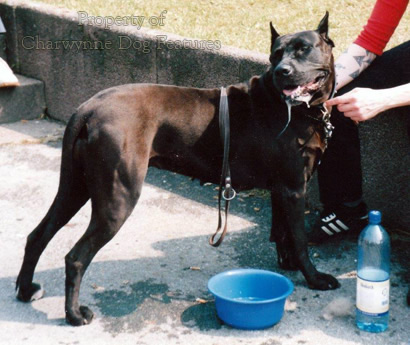
I believe it is dishonest to breed dogs with an ancient origin to a mistaken contemporary concept of their anatomy and the reasons for this shape and size. The current breed of English Mastiff makes this point for me. This breed is not the fount of all mastiff breeds; it is quite unlike its pre-dog show ancestors and was recreated in the 19th century using the blood of imported Alpine Mastiffs, Great Danes of doubtful origin and Tibetan Mastiffs, in the pursuit of great size. The Mastiff breed of today, not surprisingly, resembles a fawn Alpine Mastiff rather than the old breed of native mastiff. There is a lesson here for breeders of Neapolitan Mastiffs: don't assume that breeders in the dog's native country have got it right and don't suppress your own common sense by trying to ape foreign breeders pretending to be pursuing the classic type in the breed. Far too many breeders of pure-bred dogs have a wallet to fill rather than a conscience to satisfy!
I remain to be convinced too of the sense of the Neapolitan Mastiff (and Fila Brasileiro) being preferred by some fanciers to be higher at the croup than at the withers. This detracts from the symmetry of their appearance and affects their gait, since their hindlegs are unnaturally longer when the croup is higher than the shoulders. There is no sign of this feature in the bas-reliefs of the Assyrian hunting mastiffs, from which Neapolitan Mastiff fanciers claim their breed is descended. It does not manifest itself accepably in the sister mastiff breeds and is undesired in just about every other breed. When there is imbalance between front and rear movement, the strain on the skeleton is greater. When this imbalance is compounded by substantial weight then the strain can be harmful to the bones, the hips especially, of any four-legged animal. A 'rolling' gait may be distinctive but it may also be harmful, and increasingly so as the dog gets older. I suspect this higher croup is an undesired feature that is only claimed to be a breed point when breeders are unable to breed it out.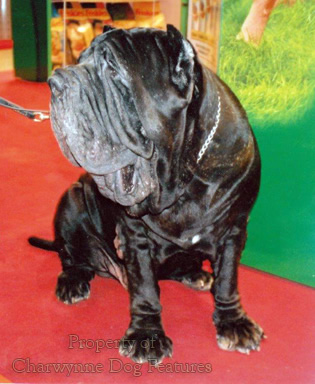
The two mastiff breeds of Italy, the Neapolitan and the Cane Corso undoubtedly share a recent common origin and can be confused even when side by side. In summary, the Neapolitan is looser-skinned, more heavily wrinkled, especially around the head and neck, and has the larger skull. I recently read an expensive Italian book on the Neapolitan where it described the Cane Corso as coming from Corsica. (The book also contained a number of photographs of ancient statues of the big cat family, claimed as mastiff dog portrayals, so desperate was the author to promote his breed). Piero Scanziani, a respected breeder and writer of the 1950s, however, linked the word 'Corso' not with Corsica but an old Italian word for robust or strong; he considered this title another name for the Neapolitan Mastiff. But now we have two separate breeds, recognised as such by the FCI.
I believe that in southern Italy there still can be found fanciers who prefer shorter-legged Neapolitans, similar to the low-slung mastini of Zaccaro, a type associated with Naples half a century ago. About that time, in Campania, near Lake Patria, Claudio Cocchia maintained a kennel of white mastini. This was more the 'dirty' white found for example in the Soft-coated Wheaten Terrier, than the pure white of say the Bull Terrier. But white does feature in the brachycephalic breeds, as the Bulldog and the Boxer demonstrate. Its association with albinism and deafness leads to its exclusion in more than one breed however.
The Neapolitan Mastiff has been called the 'cane de presa', or gripping dog, in Naples, just as the Spanish sister breeds are called Perro de Presa Canario and Perro de Presa Mallorquin and the Portuguese and Brazilian related breeds Fila de Sao Miguel and Fila Brasileiro respectively. Presa or Fila means seizing and holding and refers to the same characteristic as found in the 'beissers' further north. The dogs used to hold or grip there were called barenbeissers, for use on bears, bullenbeissers, for use on bulls and bufalbeissers when used on buffalo or bison. This group of dogs was immensely valuable to man in the hunting field before the development of firearms. Cattlemen still use them in the Azores and South America, with North American ranchers also trying them.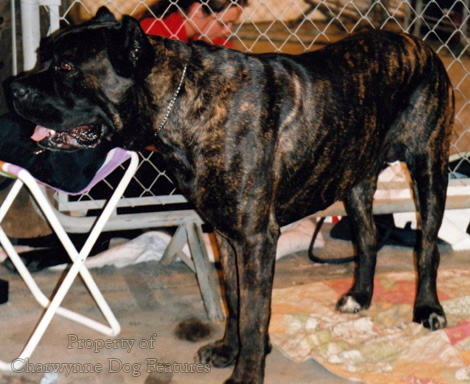
It is vital, now that the Cane Corso and the Neapolitan Mastiff have been recognised as distinct breeds, for each of them to retain their own special breed points. At the seminar for the Neapolitan Mastiff and the Dogue de Bordeaux held on the 10th of October 1999 at Essington near Wolverhampton, the Cane Corso was introduced to a British audience. Imported by Nino and Gee Lo'Raso in 1998 and then by Alan Bates of Brandoux Dogue de Bordeaux, with Bullmastiff breeder Grant Slater, in 1999, this breed should soon achieve recognition and popularity here. Resembling the Perro Cimarron of Uruguay and the Fila de Sao Miguel of the Azores, the Cane Corso lacks the exaggerated features of many other mastiff breeds. With their shortened tails and cropped ears, the imports looked very different from our native mastiff breeds. But British bred specimens will feature high-set drop ears and a full tail in due course.
The hand-out on the breed, made available at the last world show by the Italian KC, contained these words on the breed: "It has always been a property watchdog and hunter of difficult game, such as the boar. It originated in the central-southern regions of Italy where it was used as a cowherd for cows and swine raised in the wild. It also defended carters and travellers from highwaymen. Its name is the one by which it has always been known in the south, having the same root as 'corsiero' (courser), the medieval war horse; perhaps it is derived from the Latin 'cohors' (courtyard, body guard)." (I would be inclined to link the word 'corso' with the Latin 'coercere', to restrain, for that is what all the holding dogs do.) In the words of this hand-out you have the classic role of the mastiff breeds throughout history: used on boar, with feral cattle and as a battle dog/body or property guard. 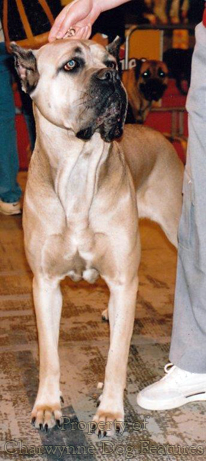
Black and tan or blue with tan is not favoured in the breed, some linking this colour combination with an alleged Dobermann cross by the dog-fighting fraternity in southern Italy. A black and tan specimen without cropped ears might well resemble a Rottweiler. I do hope this fine breed, new to Britain, doesn't attract the attention of the Dangerous Dogs Act agencies and their misguided totally unfounded policy of blaming breeds for isolated cases of unacceptable canine behaviour rather than individual animals or their owners. Holland, Spain, Ireland, some states in America and regions of Germany have now listed quite a number of breeds under their anti-dog legislation, breeds with a long and distinguished record of service to man.
The Cane Corso has a long proud record as a family protector, staunch but not savage guard-dog, cattle herder and catch-dog. It is vitally important that puppies in Britain are not sold to unsuitable owners, to be ill-used and mis-used and then mis-judged. A powerful breed like this needs a strong-minded dedicated breed club to promote its best interests and guide its early development in the UK. New breeds often attract the fickle; powerful new breeds always attract the interest of social inadequates who see their 'image' being enhanced by having a hefty, powerfully-muscled dog on their leash. This is the time for careful control of stock not the blind selling of energetic big pups to any old purchaser. One act of unwanted aggression by a powerful newly-introduced breed member can put at risk the future sales of that breed; it therefore makes commercial sense as well as common sense not to sell unwisely.
The mastiffs of Italy must be conserved as functional dogs. It is worth noting that the Alans, famous for their hunting mastiffs, were valued in Roman times for their small swift horses. In a well-known inscription found at Apta on the Durance, the Emperor Hadrian praises and commemorates his 'Borysthenes Alanus Caesareus Veredus' that 'flew' with him over swamps and hills in Tuscany as he hunted the wild boar. The Romans hunted the wild boar with hunting mastiffs; the Alans could have provided hounds as well as horses, their renowned 'alauntes'. The governors of Milan were once commended "because they mixed horses as breeders with large mares, and there have sprung up in our region noble Destriers (a medieval knight's war horse) which are held in high estimation. Also they reared Alanian dogs of high stature and wonderful courage."
This 'high stature and wonderful courage' is an admirable combination in a breed of dog; strapping brave dogs, fierce when need be but otherwise placid and tolerant, make rewarding companions. I do hope British breeders will honour the distinguished heritage of these Italian dogs and continue the work of devotees such as the Leone, Caldarola, Cilla and Principe families and enthusiasts such as Casalino, Gandolfi, Serini and Malavasi, whose kennel of Cane Corsos was selected to pioneer the first breeding scheme. The Italian breed standard for the Neapolitan Mastiff has been described as 'dauntingly geometric'; I hope this doesn't lead to its misunderstanding or worse, misuse. Whatever the wording of any standard, this key question has to be asked 'Do these words produce a sound healthy active dog, able to live a full and long life?' Any subsequent questions are for the punctilious!